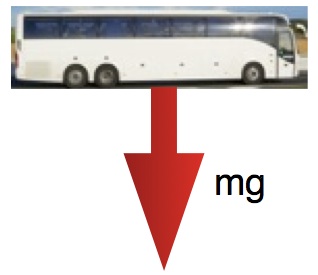This is an old revision of the document!
Example: Finding the time of flight of a projectile
An out of control bus is forced to jump from a location $\langle 0,40,-5 \rangle$m with an initial velocity of $\langle 80,7,-5 \rangle$m. Determine the time at which the bus hits the ground.
Facts
- Starting position of the bus $\langle 0,40,-5 \rangle$
- Initial velocity of the bus $\langle 80,7,-5 \rangle$
- The acceleration due to gravity is 9.8 $\dfrac{m}{s^2}$ and is directed downward.
- The bus experiences one force - the gravitational force (directly down).
Lacking
- The time the bus hits the ground.
Approximations & Assumptions
- Assume no drag effects
- Assume ground is when position of bus is 0 in the y direction
Representations
Diagram of the situation. I'm confused with what is labeled here
Diagram of forces acting on bus once it leaves the road.
Equation for determining $\Delta{t}$ in constant force situations.use vector principle; then motivate why only y matters
$y_f - y_i = v_{iy} \Delta{t} + \dfrac{1}{2} \dfrac{F_{net,y}}{m} \Delta{t^2}$
Solution
At ground $y_f = 0$; the bus initially leaves the road at $y_i = 40$.
$y_f - y_i = v_{iy} \Delta{t} + \dfrac{1}{2} \dfrac{F_{net,y}}{m} \Delta{t^2}$
$0 - 40 = v_{iy} \Delta{t} + \dfrac{1}{2} \dfrac{-mg}{m} \Delta{t^2}$
$ -40 = v_{iy} \Delta{t} + -\dfrac{1}{2} {g} \Delta{t^2}$
$ -40 -v_{iy} \Delta{t} = -\dfrac{1}{2} {g} \Delta{t^2}$
$ -40 -v_{iy} = -\dfrac{1}{2} {g} \Delta{t}$
$ 2\dfrac{{40 + v_{iy}}}{g} = \Delta{t}$
$ \Delta{t} = 9.59s$

